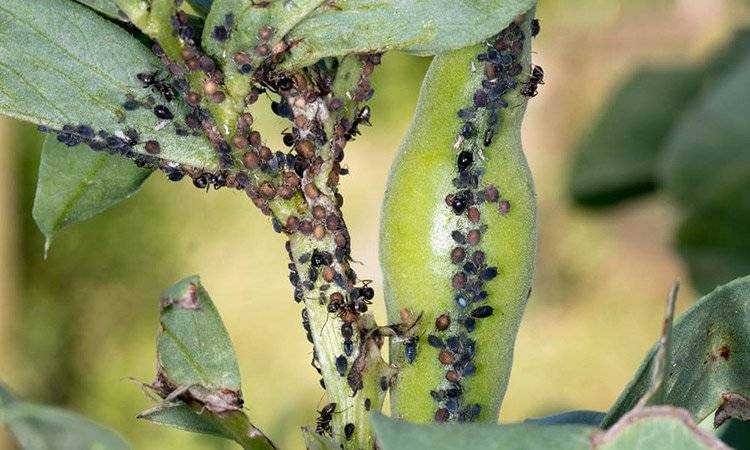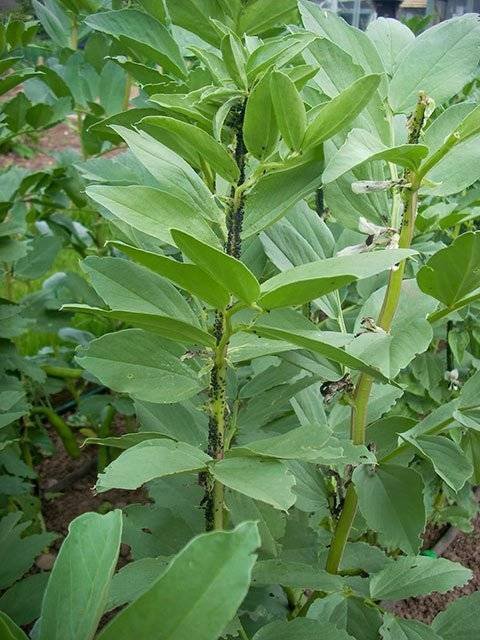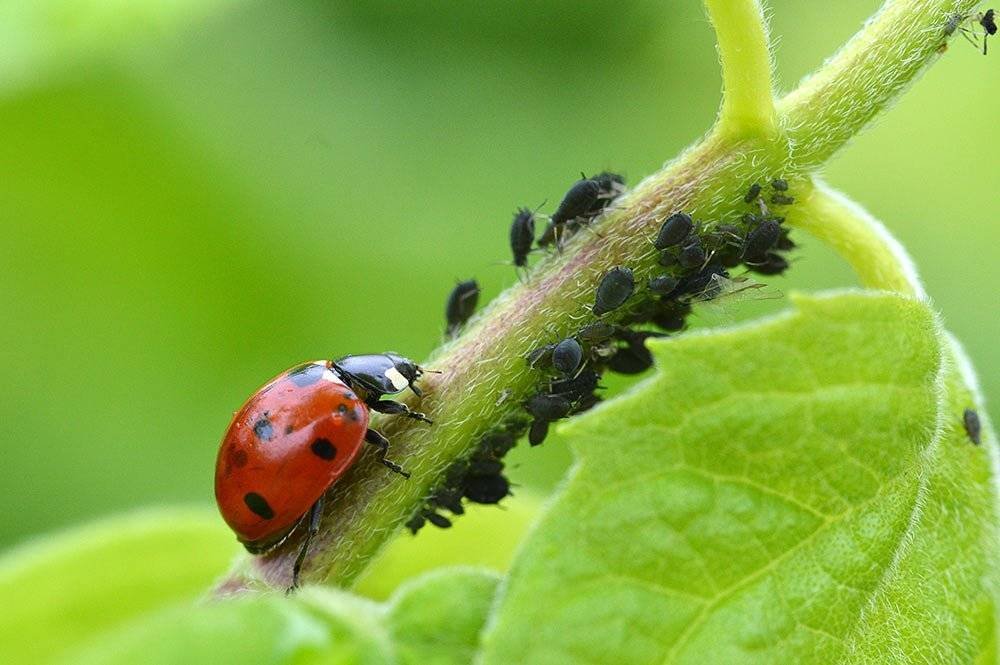Beautiful Plants For Your Interior

How to Get Rid of Blackfly on Broad Beans
In this post, we look at How to Get Rid of Blackfly on Broad Beans. We look at the symptoms, possible prevention, and cure both with ‘pesticide control’ and non-pesticide control, for blackflies or the Black Bean aphid (Aphis fabae) infestations on broad beans.
Blackfly is a general term for over 2,000 different species of these flies found in the family Simuliidae. Others in this family you would most recognise in the UK include mosquitoes, midges and other aphids.
The one we are most interested in as gardeners though is the ‘Blackfly’ species called ‘Black Bean Aphid’ (Aphis fabae) this is what gardeners ‘refer’ to when discussing their broad beans and other crops with blackfly problems.
This blackfly species (Aphis fabae) is a small, black insect that basically feeds on the ‘sap’ of plants, (particularly Broad Beans) unlike many of its blood-sucking and biting cousins. Blackflies are very small but don’t be fooled the ‘blackfly’ is a voracious eater and will infest almost any plant in the garden given the chance.
Blackflies generally overwinter on plants, and a single-winged female can produce a large population in a few weeks. They will feed on the plant’s sap and then lay eggs, and live young will be produced in a week or two when temperatures rise. Females lay eggs in the spring, and they hatch in the summer.
The Symptoms
A black bean aphid’s body measures up to 2mm in length and is primarily black with some ‘white’ specks on its upper surface. A dense accumulation of these aphids can develop on soft bean shoot tips, stems, and younger leaves.
Also look for black ants, as they often gather the ‘sugary honeydew’ that aphids excrete. Ants defend blackflies from predators in exchange for honeydew, which is a food source for the ants.
Unfortunately, this association between ants and blackflies can have detrimental consequences for broad beans. Ants in addition remove any aphid predators such as ladybird larvae.
When ants remove the aphid predator’s larvae as a result of their gathering the honeydew. A ‘whitish’ cast skin often accumulates on the host plant due to this removal process.

How to Get Rid of Blackfly on Broad Beans: Plants Heavily Infested With Blackbean Aphid
When broad bean plants are heavily infested, flower formation and bean pods are also inhibited quite severely.
You may also note that winter/spring host plants, such as viburnum (Viburnum tinctorium), and common spindle (Euonymus europaeus), often have ‘curled leaves’ as a result of aphid feeding. See companion planting below.
Prevention of Blackfly
Blackfly insects have the ability to reproduce quickly and can become a serious problem if left unchecked. So preventing such an infestation should be primary to any cure. Observation is key, from early spring check the plants regularly for blackflies and just ‘brush off’ and or use your finger and thumb to squash aphid colonies where it’s practical to do so. Even spraying with a high-pressure hose or a jet washer will do the trick for a short while.
There are a few other methods available for the prevention of blackflies in broad beans. Initially ensure you have good soil preparation with a good pH and healthy bean plants, as healthy plants are less susceptible to many plant problems.
Try planting ‘broad beans’ in the autumn, and then ‘overwintering’ them. By doing this, the ‘black bean aphid’ will not migrate to the plants during spring.
Another popular method for ‘aphid’ prevention in broad beans is to ‘pinch out’ the plants ‘tips’ when they reach their desired height, as it is here at the tip of the plant that ‘blackflies’ gather and thus is a primary ‘feeding’ location for them. This prevention method also encourages ‘greater’ growth and development of stronger more robust pods.
Ant Attacks: In a paragraph above, we discussed how ants farmed blackflies. In addition to actively farming blackflies, ants move them from plant to plant, protecting them from other predators. To keep ants away from broad beans, try rubbing household ‘Vaseline’ on the base of the stem to prevent the ants from climbing up. Natural predators like Ladybirds, birds, wasps, and hoverflies will quickly consume the remaining insects.
Don’t throw away those tips though, there is some culinary value in them. It’s all about the butter. Garlic butter should be melted and poured over the steamed, lightly butter-coated broad bean tips which then can be served as a side dish.
By undertaking some or all of these preventative measures above you will certainly save yourself time, money, and effort in the long run.
Companion Planting – Organic Control
If we eliminate pests entirely though, we may regret it later. When blackflies for instance inevitably return to areas of the garden that have been cleared of them, it’s more than likely their ‘populations’ can swell dramatically because there are no predators to control them and their prolific breeding potential..
Using another method it is possible to ‘keep blackflies away from our broad beans and other edibles as much as possible by ‘planting companion plants, in our gardens instead of eradicating blackflies completely.
Companion plants are chosen because they are more popular with blackflies than ‘broad beans’ and in turn those predators that eat them. Placing companion plants in other areas of the garden can keep black bean aphids distracted and lessen the likelihood of serious infestations in your broad beans.
One popular companion plant to use for blackflies to keep them off your broad beans is Nasturtiums (Tropaeolum majus, T. minus). Blackfly and other aphids seem to be drawn to the nasturtiums more than to beans if ‘corroborative’ evidence is to be believed. Companion planting can be used to accomplish this result in an ‘organic’ garden. It should be used in conjunction with your own ‘companion planting’ strategy.
Other ‘companion plants’ that gardeners may choose are:
Natural Control of Blackflies
Although ladybirds are probably the blackflies’ deadliest of predators, don’t count on just a few of them to handle a ‘significant’ blackfly infestation. The problem comes once a large infestation has started to build up on plants.
Blackflies often become abundant before their natural enemies like parasitoid wasps, hoverflies, green lacewings and ladybirds, whose larvae gorge on the black bean aphid (Aphis fabae), are active in sufficient numbers to control and minimise the problem.
Enter biocontrol, in this case, live ladybirds through the post. This method can be used to supplement predator numbers, as they are ‘released’ into a restricted area (Broad Bean Location) to increase the number of predators that would naturally occur at that time.

How to Get Rid of Blackfly on Broad Beans: Ladybirds Are a Good Source of Natural Control For Blackflies
Non-Pesticide Control
We have looked at natural control and companion planting for blackfly control, non-pesticide control is another method you can apply that can help with blackfly problems.
Homemade treatments or solutions include plain old washing-up liquid and water mixed with bicarbonate of soda to spray on the plants works well.
To make this simple ‘surfactant’, mix washing up liquid with water at a 1:10 ratio. When sprayed on the insects, the liquid creates an even layer of water (surfactant) that suffocates the blackflies.
Although this mixture will not eradicate all the eggs, adding bicarbonate of soda (one tablespoon per litre) to your mixture may also be used to create a more effective pesticide to ‘dehydrate’ the insects.
Another option we came across was Borax or Boric Acid and sugar. However, while this mixture may work well its ‘killing’ of insects is somewhat ‘indiscriminate’ so we do not advocate this household remedy.
Some gardeners prefer shop-bought oils like Neem oil. Neem oil is one of the most effective non-pesticide controls for blackfly treatments you can buy. You can eliminate blackflies from your broad bean plants by mixing neem oil with water and spraying it on the plant’s leaves to prevent them from landing there in the future. Spray the broad bean leaves every two weeks and after rain to accomplish this protection.
Horticultural soaps (See FAQ | Fruit & Vegetables) are composed of various components and function as surfactants, dehydrators, and organic chemical pesticides. It is typically much less expensive in the long run to purchase ‘mixed’ horticultural soaps, as they often include more than 20 ingredients. This is the best horticultural soap for broad beans we have come across in our research of the product.
Shop-bought organic plant sprays like the popular ‘Kinderpet organic plant spray’ can also be purchased that are pet-friendly and that successfully eradicate blackflies.
Pesticide Control
If you choose to use a chemical control please try and keep it to a minimum and use them only in a ‘targetted’ area where the worst and more persistent infestations occur that can not be removed or controlled by other means. Westland Resolva Bug Killer, Provanto Ultimate Fruit & Vegetable Bug Killer, Provanto Sprayday Greenfly Killer and Py Bug Killer are some of the popular brands used.
FAQ’s
Can I Eat Broad Beans That Have Been Affected By Blackfly?
Yes, you can still eat broad beans that have been affected by blackfly, but it is recommended to remove the affected leaves and wash the beans thoroughly before cooking. If the infestation is severe, it may be best to harvest the beans early and freeze them to prevent further damage
How Often Should I Check My Broad Beans For Blackfly?
It is recommended to check your broad beans for blackflies at least once a week during the growing season, especially during warm and humid weather when blackfly populations can quickly increase. Early detection and treatment can help prevent a severe infestation and reduce the risk of damage to your plants.
What is The Life Cycle of Blackfly on Broad Beans?
Blackflies on broad beans have a complex life cycle that includes wingless and winged forms. The wingless forms, known as nymphs, hatch from eggs laid on the underside of leaves and feed on the sap of the plant.
They molt several times before becoming winged adults, which can fly and lay eggs on other plants. Blackflies can reproduce rapidly and cause significant damage to plants if left unchecked.
Conclusion
There are several things you can do to avoid blackflies from damaging your plants, even if they are a nuisance. Companion planting and releasing natural predators are two examples.
You can keep blackfly populations in check by using chemical pesticides, if necessary. Whenever possible, it is preferable to use natural organic techniques. But blackflies are fascinating creatures, with adaptations that exceed our expectations, and continue to confuse us all, including their predators.
